| Article ID | Journal | Published Year | Pages | File Type |
|---|---|---|---|---|
| 8880251 | Industrial Crops and Products | 2018 | 11 Pages |
Abstract
This study evaluated costs and profitability associated with mango processing waste biorefinery plant with the goal of generating wealth from waste. Three pathways were evaluated (i) Only Pectin recovery (PEP) (ii) Pectin and Seed Oil recovery (PSEP), and (iii) whole biorefinery with multiple products (WMB). A plant capacity of 10â¯tons/h was considered as a base case for analysis. Effect of biomass feed composition on product yields were also reported in this study. The PSEP was found to be the best alternative for mango waste utilization. The NPV, IRR and PEP were $41 million, 34% and 2.4 years, respectively. In case of PEP and WMB, NPVs were $14.2 and $43.2 million; IRRs were 20% and 26%, and PBP were 4.2 and 3.4 years, respectively. Sensitivity analysis showed that plant capacity, plant operating days, and raw material composition were most important factors that influenced plant economics. Selling price of main product i.e. pectin had a major influence on plant economics. The effect of raw material price fluctuation however, did not influence plant economics significantly.
Related Topics
Life Sciences
Agricultural and Biological Sciences
Agronomy and Crop Science
Authors
Amit Arora, Jhumur Banerjee, R. Vijayaraghavan, Douglas MacFarlane, Antonio F. Patti,
